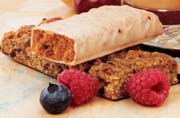
The demand for high- protein bars and beverages will continue to increase over the next few years, despite a recent downward trend,” reports David Browne, director of content development at SPINS (San Francisco) a natural products reporting agency. However, the taste of these products is variable. Many products on the market present off-notes from various nutritional components in the formulation, such as their soy or dairy protein components, B vitamins and/or caffeine.
There is a solution to the flavor problems in many high-protein bars and beverages. Virginia Dare (Brooklyn, N.Y.), a flavoring company that has been in business since 1923, carries a line of flavoring products that is specially developed for these formulation challenges. According to Evelyn Gonzalez, applications manager for functional foods for Virginia Dare, “Proteins in nutritional bars act like sponges, with many cracks and crevices that soak up and hide flavors. Our line of VidaPro® flavors is designed to coexist with the protein so you can identify the taste of the flavor throughout the shelflife of the product.”
Since flavors are “absorbed” by the proteins, what you taste when the product is first formulated is not often what you will taste two or three weeks later. “Often, companies tend to over-flavor their products to compensate. This adds unnecessary cost to the formulation, as well as a chemical taste,” says Maureen Draganchuk, vice president of business development, Virginia Dare. The company has developed the VidaPro flavor delivery system so that it now offers a full line of conventional and up and coming flavors.
It is important to understand the characteristic flavors of the high-protein bases. Soy proteins lend a bitter, green or “beany” flavor, and dairy proteins (such as caseinates), may impart dairy off-notes, such as that of powdered milk, metallic notes or even a “barnyard” taste. A base of grains, such as oat or rice, imparts “brown” notes that may not mix well with certain flavor profiles.
Virginia Dare is an industry leader in masking flavors; the company's approach to formulating with these base materials is to work with their specific profile to get them to a “neutral” flavor using masking flavors. Then, the specialized VidaPro flavors are added to obtain a desired, clean flavor.
VidaPro flavors are well-suited for high-protein beverages, as certain products in the line are specifically designed to withstand the heat processing steps to which most beverages are subjected (both UHT and retort). As often happens in these processes, traditional flavors that have been added to the beverages are stripped off as they volatilize from the heat. VidaPro flavors can withstand high heat, pressure and are very stable on the shelf. Additionally, the line offers artificial, natural and organically compliant options.
The flavors are beneficial in that they can help protect product flavor during processing and storage, and some may function as an emulsifier and/or a humectant, which helps keep the product moist. Gonzalez concludes, “What you want is a good, identifiable flavor profile up front, one that is able to last through the entire gustatory experience, whether it is a high-protein bar or beverage. That is finally possible with VidaPro.”
For more information:
Virginia Dare, Maureen Draganchuk
718-788-1776, mdraganchuk@virginiadare.com
www.virginiadare.com
